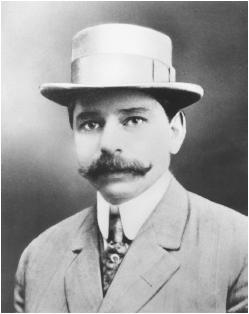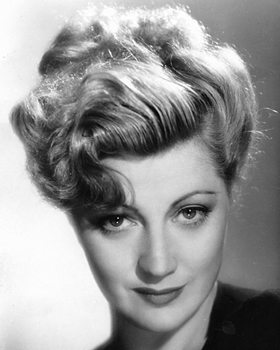Some of the most tangible and significant contributions that turn-of-the-century European immigrants provided the world were in the field of entertainment and the Lower East Side has spawned some of the most accomplished film producers, directors, actors and composers in the medium’s century-long history.
In fact without the influence of these early immigrants and their offspring, the motion picture industry as we know it would be very different today.
 |
| Screen cap from Edison’s New York City Fish Market |
Filmmakers have been attracted to the rich street scape of the East Side since the medium was introduced at the turn of 20th century. For example, some of the Edison Company’s earliest stereoscopic films included several shorts depicting life in the slums of the Lower East Side.
 |
| George Burns and Gracie Allen began on the vaudeville stage. |
American Vaudeville, which was refined at Tony Pastor’s Opera House on the Bowery in the 1870s, was a primary influence in development of early film and radio. By the time that the iconic “vaudeville hook” was introduced at Miner’s Bowery Theater in 1902, immigrants had infused their brand of song, dance and comedy which made the format so successful on the big screen.
Many of America’s earliest film and radio stars graduated from these vaudeville and immigrant theatre stages but more than that, the culture bred some of the film industry’s original power brokers and innovators of the modern movie-going experience.
 |
| Adolph Zukor, founder of Paramount Pictures |
1920’s Humoresque, the story of a Lower East Side boy from a poor Jewish family who becomes a successful violinist and brings fortune to the family, is often credited as being one of the first to promote a pro-immigrant sentiment. The film was produced by Hungarian-born, Lower East Side raised Adolph Zukor (1873-1976) and partially financed by William Randolph Hearst.
 |
| Marcus Loew, founder of Loew’s Theaters & MGM |
The Mark brothers had another investor in their blooming theater business, Lower East Side born Marcus Loew (1870-1927) – a man who dropped out of school at an early age to help support his family – and went on to establish Loews Theaters and co-found Metro-Goldwyn-Mayer studios.
 |
| William Fox, co-founder of 20th Century Fox |
With the influence of these early pioneers, a series of films were released in the 1920s focusing on life on the Lower East Side. It was an era where many first generation Americans began rebelling against their immigrant ancestry and the films almost always featured themes of generational friction, overcoming poverty, or struggling to find an identity in America.
By this time, the bulk of the movie industry had relocated to the cavernous studios of Hollywood and much of the street scape was reproduced on a sound stage. Regardless, success was overwhelming and working-class audiences flocked to theaters, treated to such East Side-themed films as The Miracle of Manhattan (1921), Hungry Hearts (1922), The New Teacher (1922), His People (1925), The Patent Leather Kid (1927), Danger Street (1928), The Madonna of Avenue A (1929), and The Younger Generation (1929).
 |
| Al Jolson |
In 1927, the first full length talkie was introduced to the general public. The Jazz Singer, written by Samson Raphaelson (1894-1983) and starring Al Jolson (1886-1950), both Lower East Side raised, was the first film to hit theaters accompanied by synchronized dialogue.
The story of a local singer caught between dreams of stardom and his family’s traditional Jewish values crossed over class boundaries and proved to be a commercial success.
 |
| Edward G. Robinson |
Dozens of gangster movies were produced during the 1930s and the tenement districts of New York City bred three of the most famous tough-guy actors of the era, including George Raft, the Hell’s Kitchen raised matinee powerhouse, and the Lower East Side’s own James Cagney (1899-1986) and Edward G. Robinson (1893-1973).
 |
| James Cagney |
Academy Award winning actor James Cagney, whose breakout role as gangster Tom Powers in 1931’s The Public Enemy led to a series of films which showcased his hard-nosed upbringing.
However, by the early 1940s, rebelling against the system was out and American patriotism was in. Cagney, an accomplished singer and dancer, broke gangster typecasting and was hired to play the lead in the 1942 blockbuster, Yankee Doodle Dandy, where his portrayal of Broadway impresario George M. Cohen earned him an Academy Award for best actor.
 |
| Stella Adler |
No article about the history of motion pictures should fail to mention Stella Adler (1901-1992), one of the most accomplished acting teachers of all time. Born on the Lower East Side in 1901 to Yiddish Theater star Jacob Adler, Stella opened the Stella Adler Studio of Acting in 1949 and trained dozens of future movies stars such as Judy Garland, Marlon Brando, and Robert De Niro.
Perhaps the only person to give Stella Adler a run for her money was “father of method acting in America,” Lee Strasberg (1901-1982), whose family immigrated to the Lower East Side from the Ukraine in 1909.
 |
| Lee Strasberg |
Strasberg, an alumni of the former Chrystie Street Settlement House’s drama club, trained the likes of James Dean, Dustin Hoffman, Marilyn Monroe and Al Pacino, and was director of the prestigious Actor’s Studio from 1951 until his passing in 1982.
And what would the movie going experience be without a film score? Some of America’s most respected composers and lyricists hail from the Lower East East Side.
Eight-time Academy Award nominated composer Irving Berlin (1888-1989), who penned such classics as “Putting on the Ritz,” “White Christmas,” and “There’s No Business Like Show Business,” started out as a singing waiter in the most raucous Bowery dives.
George Gershwin (1898-1937), who got his first piano while growing up on Second Avenue, is often remembered as a stage composer; However he provided the score to a handful of films before his untimely passing, including the song “They Can’t Take That Away from Me,” which earned an Oscar nomination for the Best Song in 1937. Sharing that nomination was George’s brother and writing partner, Ira Gershwin (1896-1983), who is considered one of the greatest songwriters of the 20th century.
 |
| Edgar Yipsel Harburg |
Former P.S. 63 student Yip Harburg (1896-1981) has transported millions of people “Somewhere Over the Rainbow,” as lyricist for one of the most successful and beloved motion pictures of all time, The Wizard of Oz.
Other pioneering Lower East Side to Hollywood transplants include Eddie Cantor, Jimmy Durante, George Burns, John Garfield and dozens more, such as Tony Curtis, Estelle Getty, Walter Matthau, Zero Mostel, and Jerry Stiller who all attended the same high school, Seward Park on Essex Street.
Without the contributions of these immigrants and their offspring, where would the entertainment industry be? What we covered here is just the tip of the iceberg. In the future we will to delve into the pioneers of television, radio, Broadway and the music industry who hailed from the Lower East Side.

Eric is a 4th generation Lower East Sider, professional NYC history author, movie & TV consultant, and founder of Lower East Side History Project.
Amazing article! No, visit to NYC would be complete the experience of the Lower East Side.